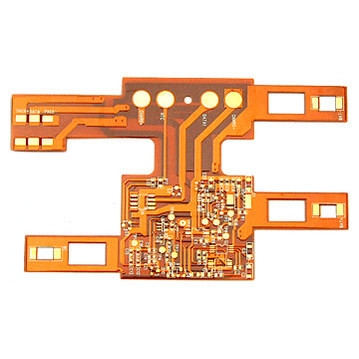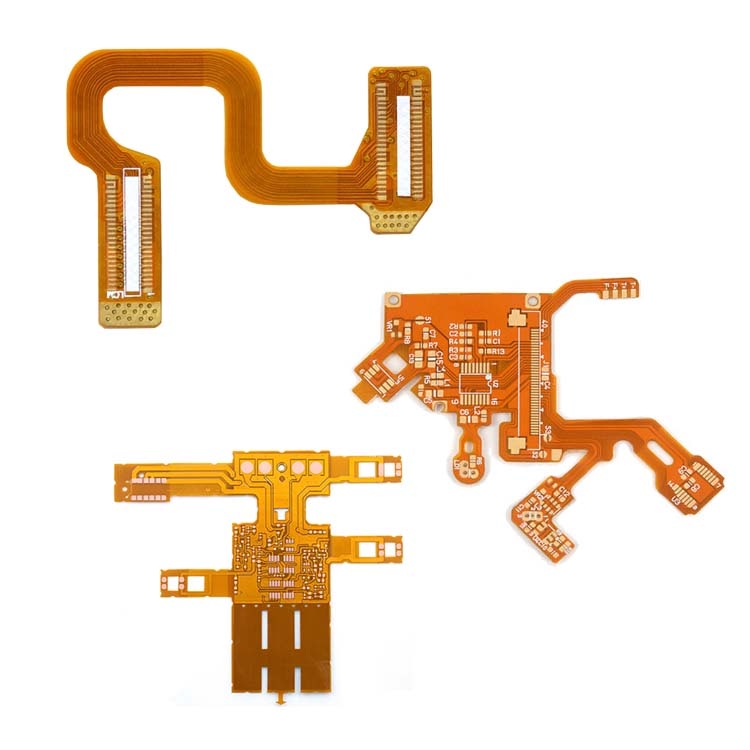Flexible Printed Circuit (FPC) technology refers to the design and assembly of electronic circuits by mounting electronic devices on flexible plastic substrates, such as polyimide or PEEK film. This technology allows the circuit to conform to a desired shape during its application, making it integral in modern electronics due to its flexibility and lightweight nature. Double-sided FPC technology enhances this flexibility by incorporating circuits on both sides of the substrate, interconnected through plated-through holes. This advancement is crucial in densely packed electronic devices, such as smartphones and wearables, where space is limited and functionality cannot be compromised. The use of double-sided FPCs not only optimizes space but also significantly boosts the circuit complexity and overall performance, marking a pivotal development in electronic design and engineering.

Understanding Double-Sided FPC Technology
Definition and Concept
A double-sided flexible printed circuit board utilizes double-sided flexible copper-clad material, often featuring openings in the coverlay on one or both sides. These boards are characterized by two conductive copper trace layers separated by an insulating layer, typically made of Polyimide. The two copper layers are electrically connected through plated-through holes (PTH), although some designs may omit PTH if the lower trace layer serves specialized functions like enhancing circuit rigidity or controlling impedance.
Key Components and Structure
The double-sided FPC's construction includes a coverlay made of Polyimide, pre-cut before lamination to allow access to trace pads and gold fingers on both sides. Alternatively, flexible oil can serve as a coverlay or solder mask to shield traces from oxidation and facilitate soldering. This design supports more complex circuit configurations than single-sided or dual-access FPCs, significantly enhancing wiring density and conserving space by allowing components to be mounted on both sides. Additional elements like stiffeners, adhesive tapes, and EMI shielding materials can be integrated into the structure as needed.
Manufacturing Process
The manufacturing of double-sided FPCs involves several precise steps:
- Material Preparation: Starting with copper-clad Polyimide film, necessary materials are prepared and cleaned.
- Circuit Printing: Circuits are printed on both sides of the substrate using photolithographic techniques.
- Etching: Unwanted copper is chemically removed, leaving the desired circuit traces.
- Drilling and Plating: Holes are drilled for PTHs and plated to establish connections between the circuit layers.
- Coverlay Application: Pre-cut coverlays are laminated onto the circuit to protect the traces and ensure accessibility to connection points.
- Testing and Finishing: The final circuit is tested for electrical functionality and reliability before being cut into individual units.
Potential Applications of Double-Sided FPC Technology
Consumer Electronics
- Smartphones and Tablets: Double-sided FPCs allow for thinner, lighter designs while accommodating more components, crucial for modern compact devices.
- Wearable Devices: The flexibility and lightweight nature of double-sided FPCs make them ideal for wearables, enhancing comfort and integration of more functionalities.
Automotive Industry
- Advanced Driver Assistance Systems (ADAS): Double-sided FPCs contribute to the compactness and reliability required in critical automotive safety systems.
- Infotainment Systems: These circuits support the complex, multi-functional electronics needed for automotive infotainment systems, enabling better performance and integration.
Medical Devices
- Medical Wearables: Double-sided FPCs are used in medical wearable devices, facilitating continuous health monitoring with devices that are comfortable and non-intrusive.
- Diagnostic Equipment: Their reliability and precision are critical in the design of diagnostic equipment, where space and accuracy are paramount.
Industrial Automation
- Robotics: Flexible, durable double-sided FPCs are suited to the dynamic and demanding environments of robotic systems.
- Sensors and Control Systems: These circuits are essential in compact and precise control systems and sensors, pivotal in modern automated industries.

Advantages of Best FPC's Double-Sided FPC Technology
Flexibility and Space Saving
Best FPC's double-sided technology maximizes the use of limited space in electronic devices by enabling the integration of more circuitry within a smaller footprint. With board thicknesses ranging from 0.10mm to 0.44mm and maximum dimensions up to 220*1,500mm, these FPCs are highly adaptable to various design constraints. The flexibility inherent in the materials used, particularly the varied thickness options of the Polyimide base from 1/2mil to 4mil, allows these circuits to conform to unique shapes and fit into tight spaces, making them ideal for compact consumer electronics and intricate medical devices.
Enhanced Design Options
The availability of copper thicknesses from 1/3OZ to 4OZ and precision features like a minimum PTH of 0.10mm and minimum line width/spacing of 2mil/2mil ensures that double-sided FPCs from Best FPC can support a wide range of electrical requirements and high-density applications. This versatility enhances design options for engineers, allowing for the creation of more complex and functional multi-layer circuits.
Improved Reliability
Best FPC's strict control over impedance, offering popular values like 50 ohm, 90 ohm, and 100 ohm, and the ability to provide other values, ensures that each circuit delivers consistent performance with minimized signal loss and interference. This reliability is crucial in applications such as automotive safety systems and critical medical devices, where consistent and predictable electronic behavior is mandatory.
Cost-Effectiveness
Utilizing double-sided FPCs significantly reduces the need for multiple single-sided boards, thereby not only conserving material but also simplifying the assembly process. This consolidation reduces overall manufacturing costs and streamlines production, offering economic benefits without compromising on the quality or performance of electronic devices. Additionally, the robust nature of these FPCs, paired with their resistance to environmental factors such as heat and moisture due to high-quality materials like Polyimide, ensures long-term durability, reducing the need for frequent replacements and lowering lifecycle costs.
Challenges and Limitations
Design Complexity
Double-sided FPCs, while versatile, introduce significant complexities in the design phase. The intricate nature of placing circuits on both sides of the substrate requires precise alignment and detailed planning to avoid interference between components. This complexity can increase the time and cost of design, demanding highly skilled engineers and advanced CAD tools.
Manufacturing Constraints
The production of double-sided FPCs involves sophisticated processes like precise drilling, accurate alignment of layers, and careful control of chemical etching. These requirements limit the speed of manufacturing and raise the potential for production errors, impacting scalability and increasing waste, especially in high-volume environments.
Reliability Issues
While double-sided FPCs are generally reliable, the introduction of more components and connections can raise the risk of failures due to physical stress and environmental factors. Ensuring consistent quality across both sides of the board, particularly in terms of soldering and hole plating, is crucial but challenging, potentially leading to increased defect rates.
Compatibility with Traditional Electronics
Integrating double-sided FPCs with traditional rigid PCBs can pose compatibility issues. Differences in thermal expansion, flexibility, and connectivity need careful management to ensure reliable interconnections and functional integration within hybrid systems.
Future Prospects and Opportunities
Growth Potential in Various Industries
The versatility of double-sided FPC technology promises significant growth in industries like consumer electronics, automotive, and healthcare, where innovation drives demand for more compact and efficient devices. These industries benefit particularly from the space-saving and design flexibility that double-sided FPCs offer.
Potential for Innovation and Collaboration
Emerging technologies such as foldable displays and advanced sensors provide new avenues for innovation in FPC design. Collaboration between FPC manufacturers and technology companies can lead to breakthroughs in materials and manufacturing techniques, enhancing the capabilities and applications of FPCs.
Addressing Remaining Challenges
Ongoing advancements in material science and production technology are expected to mitigate many of the current limitations of double-sided FPCs, improving manufacturing efficiency and reliability. These developments will help in overcoming the challenges related to design complexity and production constraints.
Market Forecast and Predictions
The global market for FPCs is projected to expand significantly, driven by trends in miniaturization and smart technology. The introduction of more environmentally friendly materials and processes is also expected to boost the market, aligning with the growing emphasis on sustainability in electronics manufacturing. As industries continue to evolve, double-sided FPCs will play a crucial role in the next generation of electronic innovations.
Closing Thoughts
Best FPC's Double-sided FPC technology is a key innovator within the electronics industry, providing significant benefits such as enhanced design flexibility, optimal space utilization, and increased functional density. Although it encounters challenges like intricate design requirements and manufacturing limitations, ongoing progress in material science and fabrication methods propels this technology forward. As it continues to develop, double-sided FPCs are poised to transform industries like consumer electronics, automotive, and healthcare, facilitating the creation of devices that are more compact, efficient, and dependable. Looking ahead, the technology promises expansive opportunities for growth and further innovation, positioning double-sided FPCs as central to the next generation of technological breakthroughs.










 2024-05-16
2024-05-16
 BEST
BEST

.png)
.png)
.png)
.png)

.png)

